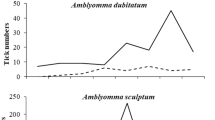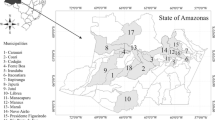Abstract
In the present study the tick prevalence, mean intensity of infestation and species were recorded on birds captured between January 2009 and December 2010 in the Ecological Station Pirapitinga-ESEC from Minas Gerais State, Brazil. A total of 967 birds, from 15 families and 40 species were captured and 165 (17.1 %) individuals were parasitized by ticks. Of these 160 (97 %) belonged to the order Passeriformes. Five tick species were identified: Amblyomma longirostre (n = 274) was the most common species followed by Amblyomma parvum (n = 43), Amblyomma nodosum (n = 39), Amblyomma ovale (n = 24) and Riphicephalus sanguineus (n = 7). None of 61 unengorged larvae molted to nymph. The mean intensity of infestation was 2.7 ± 2.4 ticks per bird (448 ticks/165 birds) ranging from 1 to 10. Only 19 (11.4 %) birds were infested with one species of tick. The remaining birds were infested by two, three or four species of ticks. Also new hosts for all five ticks were recorded. Only nymphs were recorded throughout the year with two similar peaks during autumn and winter 2009 and 2010.

Similar content being viewed by others
References
Barros-Battesti DM, Arzua M, Pichorim M, Keirans JE (2003) Ixodes (Multidentatus) paranaensis n. sp. (Acari: Ixodidae) a parasite of Streptoprocne biscutata (Sclater 1865) (Apodiformes: Apodidae) birds in Brazil. Mem Inst Oswaldo Cruz 98:93–102
Barros-Battesti DM, Arzua M, Bechara GH (2006) Carrapatos de importância médico-veterinária da região neotropical: um guia ilustrado para identificação de espécies. Vox/ICTTD-3/Butantan, São Paulo pp 223
Bush AO, Lafferty KD, Lotz JM, Shostak AW (1997) Parasitology meets ecology on its own terms: Margolis et al. revisited. J Parasitol 83:575–583
Cançado PH, Piranda EM, Mourão GM, Faccini JLH (2008) Spatial distribution and impact of cattle-raising on ticks in the pantanal region of Brazil by using the CO2 tick trap. Parasitol Res 103:371–377
Faccini JLH, Barros-Battesti DM (2006) Aspectos gerais da biologia e identificação de carrapatos. In: Barros-Battesti DM, Arzua M, Bechara GH (eds) Carrapatos de importância médico-veterinária da Região Neotropical: um guia ilustrado para identificação de espécies, 1st edn. Vox/ICTTD-3/Butantan, São Paulo, pp 5–10
Faccini JLH, Cardoso ACB, Onofrio VC, Labruna MB, Barros-Battesti DM (2010) The life cycle of Amblyomma auricularium (Acari: Ixodidae) using rabbits (Oryctolagus cuniculus) as experimental host. Exp Appl Acarol 50:71–77
Ferreira I, Ventura PEC, Luz HR (2010) Aves no campus da Universidade Federal Rural do Rio de Janeiro. Editora da Universidade Federal Rural do Rio de Janeiro, Seropédica
Guglielmone AA, Beati L, Barros-Battesti DM, Labruna MB, Nava S, Venzal JM, Mangold AJ, Zabó MPJ, Martins JRG, González-Acunã D, Estrada-Penã A (2006) Ticks (Ixodidae) on humans in South America. Exp Appl Acarol 40:83–100
Hildebrandt A, Franke J, Meier F, Sachse S, Dorn W, Straube E (2010) The potential role of migratory birds in transmission cycles of Babesia spp., Anaplasma phagocytophilum and Rickettsia spp. Ticks Tick Borne Dis 1:105–107
Ioannou I, Hochlakis D, Kasinis N, Anayiotos P, Lyssandrou A, Papadopoulos B, Tselentis I, Saroulaki A (2009) Carriage of Rickettsia spp., Coxiella burnetii and Anaplasma spp. by endemic and migratory wild birds and their ectoparasites in Cyprus. Eur Soc Clin Microbiol Infect Dis 4:1–3
Jordan BE, Onks KR, Hamilton SW, Hayslette SE, Wright SM (2009) Detection of Borrelia burgdorferi and Borrelia lonestari in birds in Tennessee. J Med Ent 46:131–138
Labruna MB, Jorge R, Sana D, Jácomo A, Kashivakura C, Furtado M, Ferro C, Perez S, Silveira L, Santos JRT, Marques S, Morato R, Nava A, Adania C, Teixeira R, Gomes A, Conforti V, Azevedo F, Prada C, Silva J, Batista A, Marvulo M, Morato R, Alho C, Pinter A, Ferreira P, Ferreira F, Barros-Battesti DM (2005) Ticks (Acari: Ixodida) on wild carnivores in Brazil. Exp Appl Acarol 36:151–165
Labruna MB, Sanfilippo LF, Demetrio C, Menezes AC, Pinter A, Guglielmone AA, Silveira LF (2007) Ticks collected on birds in the state of São Paulo, Brazil. Exp Appl Acarol 43:147–160
Marini MA, Lobo Y, Lopes LE, França LF, Paiva LV (2009) Biologia reprodutiva de Tyrannus savana (Aves, Tyrannidae) em cerrado do Brasil central. Biota Neotropica 9:55–63
Martins JR, Medri IM, Oliveira CM, Guglielmone AA (2004) Ocorrência de carrapatos em tamanduá-bandeira (Myrmecophaga tridactyla) e tamanduá-mirim (Tamandua tetradactyla) na região do Pantanal Sul Mato-Grossense, Brasil. Ciência Rural 34:293–295
Martins TF, Onofrio VC, Barros-Battesti DM, Labruna MB (2010) Nymphs of the genus Amblyomma (Acari: Ixodidae) of Brazil: descriptions, redescriptions, and identification key. Ticks Tick Borne Dis 1:75–99
Mullins MC, Lazzarini SM, Picanço MCL (2004) Amblyomma parvum a parasite of Dasypus kappleri in the state of Amazonas, Brazil. J Agr Sci 42:287–291
Nava S, Szabo MPJ, Mangold AJ, Guglielmone AA (2008) Distribution, hosts, 16S rDNA sequences and phylogenetic position of the Neotropical tick Amblyomma parvum (Acari: Ixodidae). Ann Trop Med Parasitol 102:409–425
Nava S, Velazco PM, Guglielmone AA (2010) The first record of Amblyomma longirostre (Koch, 1844) (Acari: Ixodidae) from Peru, with a revision of its host range. Syst Appl Acarol 15:21–30
Ogrzewalska M, Pacheco RC, Uezu A, Ferreira F, Labruna MB (2008) Ticks (Acari: Ixodidae) infesting wild birds in an Atlantic Forest area in the state of São Paulo, Brazil, with isolation of Rickettsia from the tick Amblyomma longirostre. J Med Ent 45:770–774
Ogrzewalska M, Pacheco RC, Uezu A, Richtzenhain LJ, Ferreira F, Labruna MB (2009a) Ticks (Acari: Ixodidae) infesting birds in an Atlantic rain forest region of Brazil. J Med Ent 46:1225–1229a
Ogrzewalska M, Uezu A, Labruna MB (2009b) Ticks (Acari: Ixodidae) infesting wild birds in the eastern Amazon, northern Brazil, with notes on rickettsial infection in ticks. Parasitol Res 106:809–816b
Ogrzewalska M, Uezu A, Labruna MB (2011) Ticks (Acari: Ixodidae) infesting wild birds in the Atlantic Forest in northeastern Brazil, with notes on rickettsial infection in ticks. Parasitol Res 108:665–670
Pacheco RC, Moraes-filho J, Nava S, Brandão PE, Richtzenhain LJ, Labruna MB (2007) Detection of a novel spotted fever group rickettsia in Amblyomma parvum ticks (Acari: Ixodidae) from Argentina. Exp Appl Acarol 43:63–71
Piranda EM, Cançado PHD, Raia VA, Almeida TK, Labruna MB, Faccini JLH (2008) The effect of temperature and fasting period on the viability of free-living females of Rhipicephalus sanguineus (Acari: Ixodidae) under laboratory conditions. Exp Appl Acarol 45:211–217
Rojas R, Marini MA, Coutinho MTZ (1999) Wild birds as hosts of Amblyomma cajennense (Fabricius, 1787) (Acari: Ixodidae). Mem Inst Oswaldo Cruz 94:315–322
Scott JD, Fernando K, Banerjee SN, Durden LA, Byrne SK, Banerjee M, Mann RB, Morshed MG (2001) Birds disperse ixodid (Acari: Ixodidae) and Borrelia burgdorferi-infected ticks in Canada. J Med Ent 38:493–500
Seasonal prevalence of tick nymphs on birds captured in the Ecological Station Pirapitinga—ESEC, Minas Gerais state (MG), Brazil, 2009–2010
Sick H (1997) Ornitologia Brasileira. Editora Nova Fronteira, Rio de Janeiro
Soares JF, Soares CDM, Gallio M, Silva AS, Moreira JP, Monteiro SG, Barros-Battesti DM (2008) Occurrence of Amblyomma longirostre in Ramphastos dicolorus in Southern Brazil. Ciência Rural 39:930–932
Szabo MPJ, Olegfirio MMM, Santos ALQ (2007) Tick fauna from two locations in the Brazilian savannah. Exp Appl Acarol 43:73–84
Szabó MPJ, Tolesano-Pascoli GV, Júnior OM, Franchin AG, Torga K (2008) Brown dog tick Rhipicephalus sanguineus parasitizing the bird Coereba flaveola in the Brazilian Cerrado. Ciência Rural 38:543–545
Tolesano-Pascoli GV, Torga K, Gabriel FA, Ogrzewalska M, Gerardi M, Olegário MMM, MB Labruna, Szabó MPJ, Júnior OM (2010) Ticks on birds in a forest fragment of Brazilian cerrado (savanna) in the municipality of Uberlândia, State of Minas Gerais, Brazil. Rev Brasil Parasitol Vet 19:244–248
Acknowledgments
We are grateful to Dr. Marcelo Bahia Labruna for reviewing the manuscript and the staff of ESEC-Pirapitinga for helping with bird capture. This work was supported by Coordenação de Aperfeiçoamento de Pessoal de Nível Superior (CAPES–MEC) and Conselho Nacional de Desenvolvimento Cientıfico e Tecnologico (CNPq).
Author information
Authors and Affiliations
Corresponding author
Rights and permissions
About this article
Cite this article
Luz, H.R., Faccini, J.L.H., Landulfo, G.A. et al. Bird ticks in an area of the Cerrado of Minas Gerais State, southeast Brazil. Exp Appl Acarol 58, 89–99 (2012). https://doi.org/10.1007/s10493-012-9572-7
Received:
Accepted:
Published:
Issue Date:
DOI: https://doi.org/10.1007/s10493-012-9572-7




